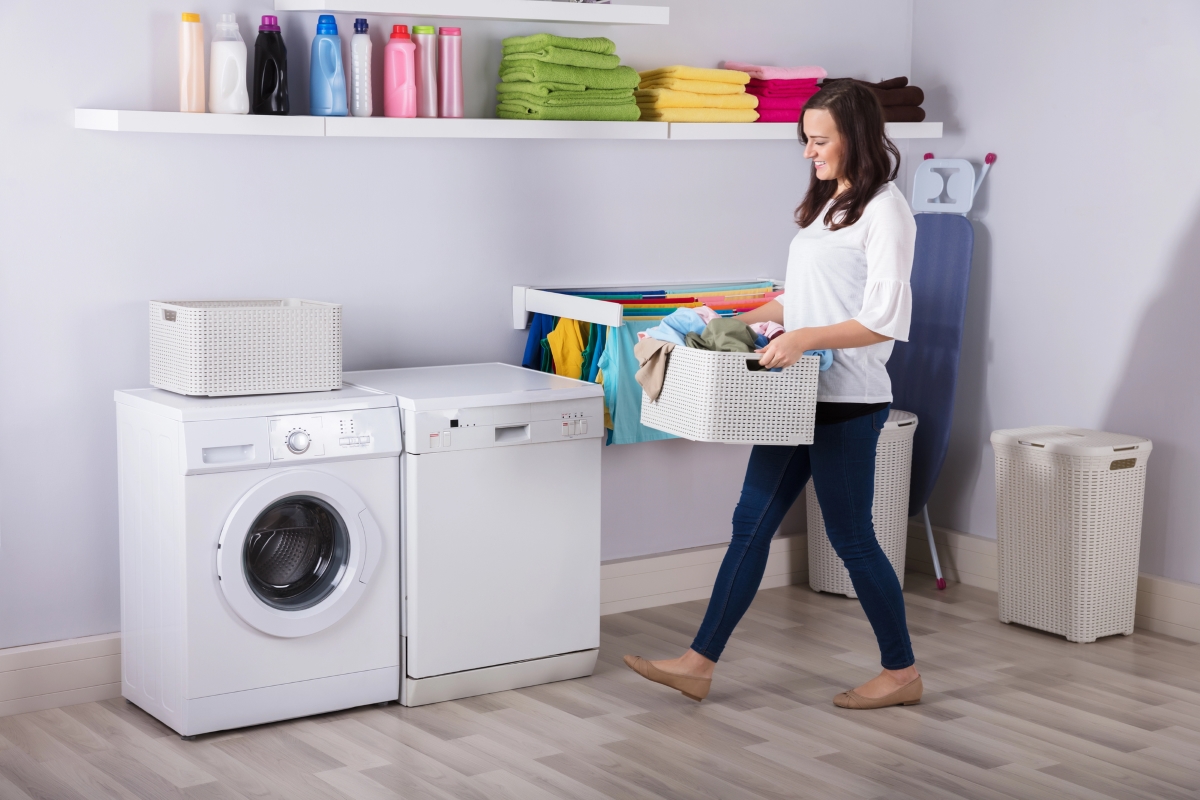

We may earn revenue from the products available on this page and participate in affiliate programs. Learn More ›
Replacing torn, worn, or outmoded flooring is a surefire way to lend a fresh look to your laundry room. But this particular space has traditionally been challenging to outfit since it’s vulnerable to damage from so many sources: stains from spilled or splattered bleach, warping or mold growth from appliance leaks, and dents from swapping out one or both of the heavy appliances. And, if your laundry room is located in the mudroom, your flooring faces additional threats like sopping umbrellas and mud tracked in from the outdoors.
To withstand all of this wear and tear, your new laundry room flooring should tick the following boxes at a minimum:
- Moisture-resistant to minimize water and humidity absorption and keep floors from swelling, warping, and molding
- Stain-resistant to prevent everyday spills and splatters from permanently setting in
- Impact-resistant to fend off scratches and dents from foot traffic or appliances moves
- Easy to clean to keep upkeep low
- Long-lasting to allow your floor to stay put longer without replacement
- Affordable to keep you within budget
- Aesthetically pleasing ideally offering a range of styles to fit in with the design scheme
Ahead, we assess the pros and cons of five popular laundry room flooring ideas and rule out three that aren’t worth the cost or trouble.
Carpet, hardwood, vinyl, and tile flooring.
Bob Vila has partnered with Empire Today to help you easily get beautiful new floors at a great price.
1. Luxury vinyl tile
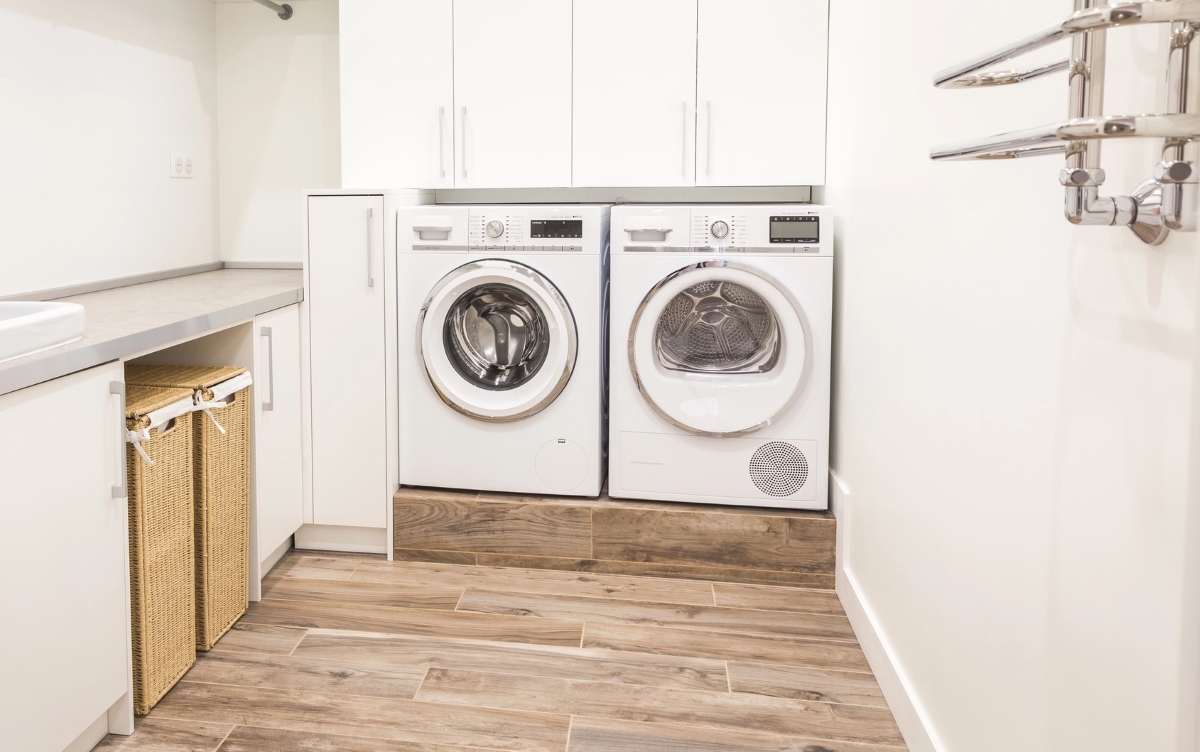
Luxury vinyl tile (LVT) consists of multiple fused layers of material—most commonly a vinyl backing, a vinyl core, a printed design that can imitate more luxury materials, and a clear top “wear” layer. The outer-facing protective layer gives the flooring the waterproof and scratch-, stain-, and dent-resistance needed to withstand the high volume of moisture, humidity, and foot traffic in the laundry room and/or mudrooms. With only dry sweeping, wet mopping with soapy water, and the occasional finishing with acrylic sealer, the laundry room flooring will last for 10 to 30 years or longer. (There’s no grout, so there’s no need for grout cleaning.)
As you might guess from the name, LVT is more expensive than sheet vinyl; it ranges from $0.50 to $12 per square foot in materials, according to cost guides on Home Advisor, a home improvement planning website.
But, some consumers will say it’s worth the extra money:
- LVT is thicker and thus quieter, more insulating, and softer.
- It’s also a step up in the looks department as the printed layer can be made to look like higher-end materials, namely hardwood or stone.
- You can install the tiles directly over existing flooring, and their small size—usually 12 inches by 12 inches—makes them easier to replace than sheet vinyl.
Just watch out for irregularities or unevenness in the substrate, which may show through the flooring and cause gaps or lifts around edges.
2. Sheet vinyl
Pros: Cheapest vinyl option; affords lots of looks
Cons: Larger sheets are harder to install and replace; doesn’t offer as much impact resistance
The most budget-friendly vinyl option, at $0.50 to $5 per square foot, according to Home Advisor, sheet vinyl can appear as a solid color or a printed design. This type of flooring is glued down to the laundry room subfloor in large, 6′- to 13′-wide sections, which makes for fewer seams than LVT flooring but also a more difficult do-it-yourself installation. Also, when damaged, entire sheets must be replaced at a time.
Like LVT, sheet vinyl is waterproof and stain- and scratch-resistant, and, as a grout-free floor type, it needs only dry sweeping or wet mopping. However, it’s thinner than LVT, and therefore offers less insulation against the cold and sound and is more prone to denting or tearing from fallen objects or appliance moves. It lasts only five to 20 years or more.
3. Ceramic tile
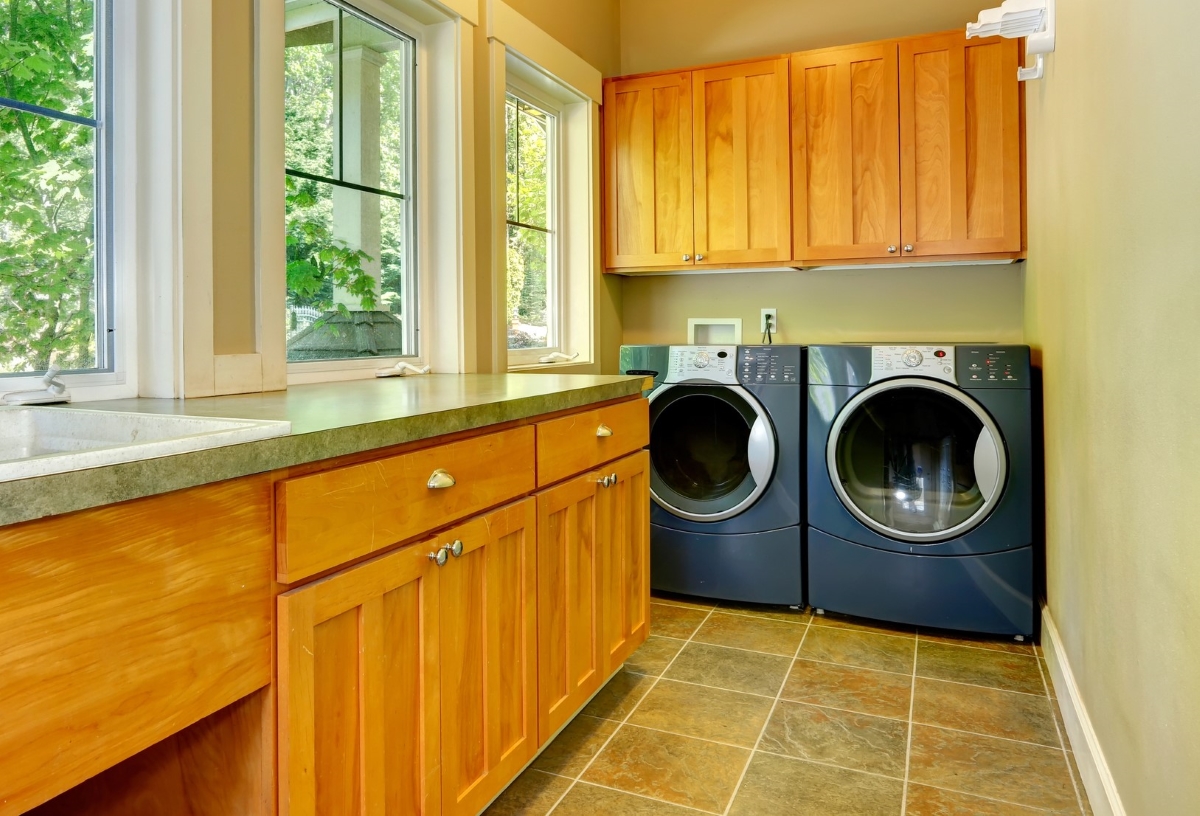
Pros: Cheapest entry price; DIY-friendly installation and replacement
Cons: Grout grunge adds to cleaning effort; slippery
Anywhere from $2 to $15 per square foot, according to Home Advisor, ceramic tile boasts a good starting price for laundry room flooring. You can find it sold glazed or unglazed, individual blocks of varying shapes and sizes or in pre-laid mosaic tile sheets that forgo the need for individual tile setting. And these clay-based tiles can be further customized through the use of tinted grout between tiles. But you’ll need to scrub the grout with an abrasive agent like baking soda, as well as regularly dry sweep and wet mop the tile to keep it clean.
Otherwise, glazed ceramic tile offers strong moisture, chemical, and stain resistance over its 10- to 20-year lifespan, even when faced with standing water (a real possibility in combo laundry-and-mudrooms). Unglazed tile first needs to be sealed with a penetrating tile sealer to provide these protections. All ceramic tile is slipperier, colder, and noisier than other laundry room flooring options, so know that the whirring of the washer or dryer is more likely to reverberate on this type of flooring. Choosing certain heated and/or textured ceramic tile can create more warmth and traction underfoot.
4. Stone
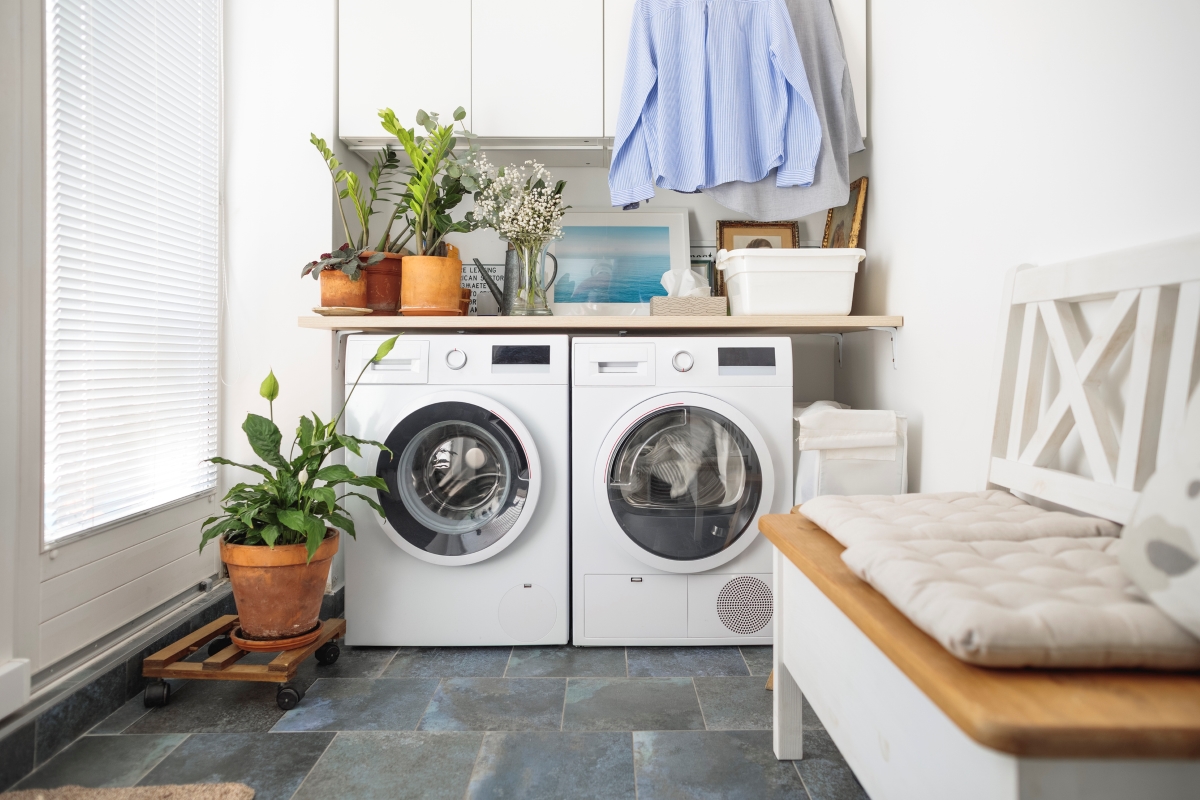
Pros: Lasts the longest; leads to higher home resale value (which can offset high costs)
Cons: Costs the most; large and weighty tiles deter DIY installation and replacement
You can’t beat the durability of natural stone tiles made of slate, marble, travertine, limestone, or similar materials—not when they offer between 20 years to a lifetime of protection from moisture, stains, and dents! You’ll pay a high price for the luxurious looks and virtual indestructibility, anywhere from $4 to $20 per square foot, according to Home Advisor, but this cost can partially be offset by the higher resale value of homes with stone surfaces.
In addition to dry sweeping and wet mopping the stone tile with a stone-specific or other pH-neutral cleaner, or soapy water, you’ll need to de-grunge grout with an abrasive agent like baking soda and water, as well as seal the tile with a stone sealer to prevent floor marks.
Like ceramic tile, stone laundry room flooring will feel cold and slippery, but you can avert this by installing heated and textured stone. Keep in mind that the heavyweight and large size of the tiles—anywhere from 12×12 to 18×18 inches—coupled with the potential need for two layers of subflooring makes it difficult for most homeowners to install or replace themselves. The price of professional installation and any repairs should be factored into the estimated cost of this flooring.
5. Laminate flooring
Pros: Resists fading; provides better moisture resistance when seams are glued
Cons: Generally more vulnerable to moisture; sounds hollow
Laminate flooring, available for $0.7 to $2 per square foot, according to Home Advisor, consists of easy-to-install interlocking planks made of backer paper, a wood-based core, a printed paper layer, and a wear layer. The printed layer can be made to look like natural materials such as wood or stone, simple solids, or complex patterns. The wear layer effectively preserves the floor color when exposed to sunlight and protects the flooring from scratches, dents, and scuffs.
But its core being a wood product, the flooring produces a hollow sound when walked over that can annoy the sound-sensitive. (You may be inclined to layer with rugs.) More importantly, laminate flooring can swell or warp with heavy water exposure, which makes it a less ideal option when your laundry appliances are located in a mudroom. This also means you also shouldn’t wet mop it—only vacuum, sweep, and wipe up spills as they occur, and dry mop it with a light spray of water.
Aqua Defense Waterproof Laminate Wood Flooring
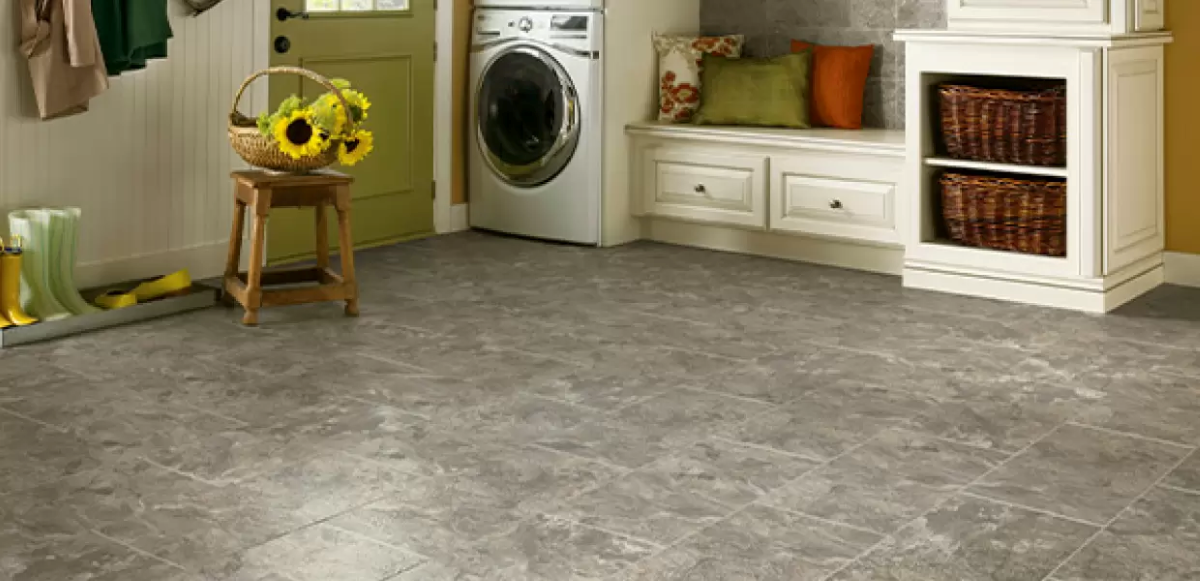
This exclusive laminate flooring option from Empire Today is among the best flooring for laundry rooms thanks to its fully waterproof protection. When coupled with the optional Aqua Defense protection, this flooring can handle heavy spills and even standing water, so it’s perfect for laundry room flooring.
For a seamless look in your home, you can also opt for the same wood laminate flooring throughout your space, and upgrade the planks with Aqua Defense for certain areas prone to getting wet (like the kitchen, bathroom, or laundry room). This provides excellent water protection where you need it, while maintaining the same flooring design throughout.
Empire Today’s wood laminate flooring is available in multiple gray and brown tones. Many of these options are covered by limited lifetime warranties to protect against wear, stains, and fading.
If you want your laminate floor to live up to its potential lifespan of 10 to 30 years, consider applying a bead of water-resistant PVA (polyvinyl acetate) glue to the tongue (i.e. flat edge) of planks before interlocking them; it will act as a barrier to moisture. Similarly, identify and repair laundry room leaks early, and avoid air-drying dripping garments in a laundry room where this type of flooring is installed.
Avoid These 3 Types of Flooring in Laundry Rooms
While LVT, sheet vinyl, ceramic tile, stone, and laminate all have the makings to be attractive and durable laundry room flooring, there are still some options that fall short. Beware of the pitfalls of the following three picks.
1. Carpet
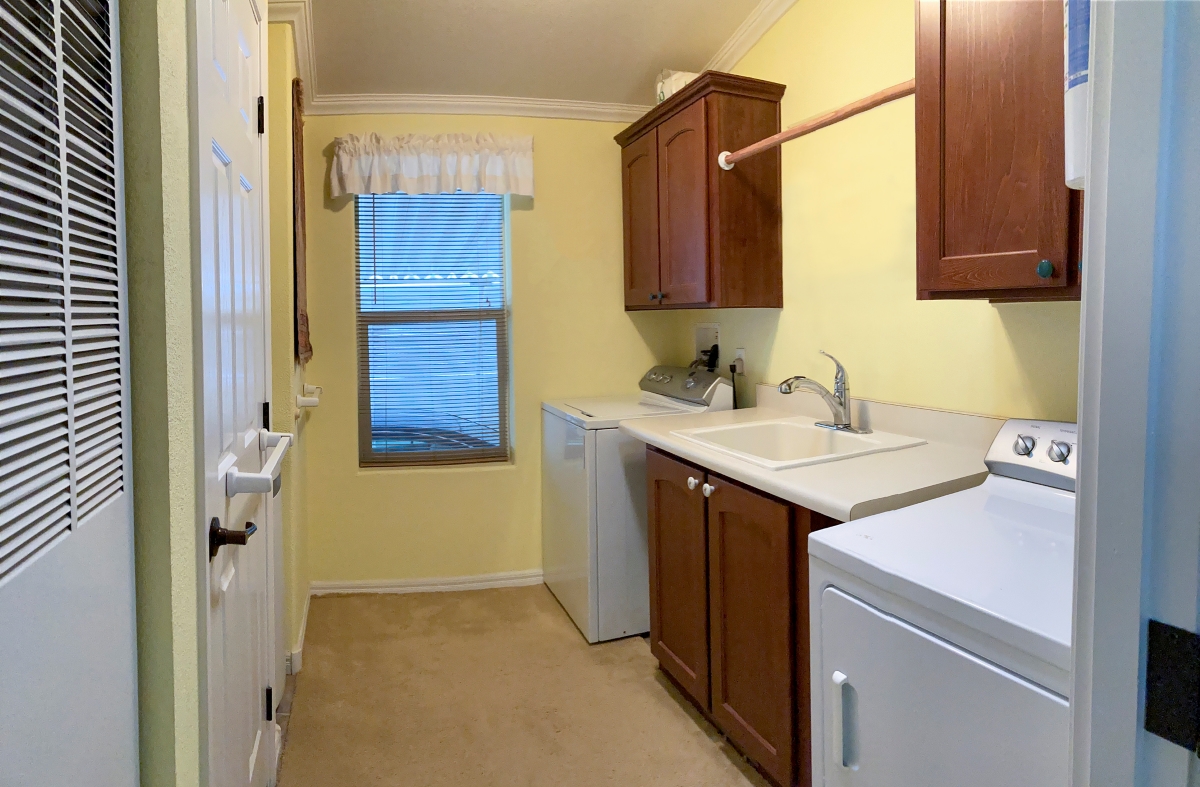
Though relatively low in cost ($2 to $7 per square foot, according to Home Advisor) and warm and cushy underfoot, carpet is the worst candidate for laundry rooms. Its nap readily catches laundry lint and dust as well as absorbs water from appliance leaks, overflows, and detergent or other chemical splashes.
The longer the pile, the slower the carpet takes to dry and the more likely it is that mold, stains, and musty smells will take root in your carpet. You may even find yourself forced to replace it before its 10-year lifespan is up.
2. Hardwood
Available for $3 to $14 per square foot, according to Home Advisor, hardwood is certainly worthwhile in other interiors where it can be expected to last 20 years or longer. But its natural warmth, radiance, and durability are all diminished in the laundry room. Moisture can warp and/or rot it, while high foot traffic, replacement of appliances, and spills can lead to splinters, gouges, or stains.
You can certainly patch gouges with wood filler and seal the hardwood to improve its moisture resistance, but these tasks have to be repeated on a regular basis, which may not be worthwhile in a non-public space like the laundry room.
3. Bamboo
Made from bamboo poles or stems, bamboo can be two to three times harder than certain hardwoods like pine and offer similar lifespan (20 years and up) for the lower price of $5 to $15 per square foot, according to Home Advisor.
Still, the sustainable flooring material can be prone to scratches or dents from pets, foot traffic, or appliances; if your planks have been tinted brown through a carbonization process, they may have been made even softer and more vulnerable to such impacts. In addition, high humidity, spills, leaks, or minor flooding can cause the floor to swell, warp, or rot, while overly dry conditions can shrink and crack the floor.
